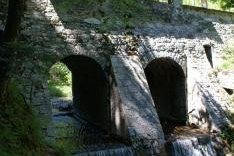
I visited Idrija, the Slovenian part of the WHS, in May 2012, expecting that it would be inscribed a few weeks later. Idrija is a small town with about 6000 inhabitants, 50 km from Ljubljana on the junction of the subalpine and the karst areas. The town lies in a picturesque valley surrounded by forest, quite unusual for a mining town. Mercury was mined for 500 years and until its closure Idrija was the second largest mercury mine, Almadén being the first. The WHS consists of seven parts: the old town, two other sites in the vicinity of the town centre, and four water barriers located in the surrounding mountains.
The historic mine, the Anthony's Shaft dating from 1500, is situated in the old town and is open to visitors. The guided tour takes 1.5 hours, it starts with a 20 minute multivision presentation. The oldest mine galleries are narrow and you have to bend down several times, the newer mine tunnels are wider and higher. The different steps of mercury mining and the techniques and tools that were used over the centuries are explained. And you can also see the underground chapel dating from the 18th Century. It was interesting to learn about the specifics of mercury mining. The mercury ore deposit is relatively small: 1500 m long, 600 m wide and 400 m deep, just below the town. In Idrija the metal was found both in its elemental liquid form and as cinnabar ore (mercury sulfide). However, the tour was very similar to other mining sites, nothing extraordinary.
In the old town are several buildings that are associated with mining: the entrance building to the Francis' Shaft (now a technology museum with pumps, engines and other devices), nearby a historic miner's house, the Castle Gewerkenegg (formerly the administration of the mining company, now the Municipal museum), a miner's theatre, a school building. The second part, about one km from the city centre, is the smelting plant, which needs to be reconstructed. It can only be visited from the outside.
The third part is located at the outskirts of Idrija close to the historic entrance of the Joseph's Shaft and comprises of a large water wheel (Kamšt) from 1790 and a water channel (Rake). But beware: the pump house is not regularly open, you have to ask for a guided tour at the museum. Unfortunately, we missed that. A trail leads alongside the Rake water channel through a nice forest with beeches and firs and ends after 3 km at the Kobila dam and the Wild Lake (Divje jezero). The dam and the Rake channel were used to regulate the water flow for the drive of water wheels and the transport of tree trunks that were used for supporting the mine tunnels.
The final parts of the site are four water barriers (klavže) on the Idrijca and Belca river. If you continue on the hiking trail at the Wild Lake, you would reach two of the water barriers after about 12 km. But this was a bit too far, so we decided to return and tried to go as far as possible by car. First, we drove on an asphalt road to Idrija Bela, a small village with a few houses, where you can bathe in the river. Then, after one kilometre the road became bumpy and narrow. We parked our car and went further by foot. After about 5 kilometres (moderatly uphill along the Belca) we reached the first water barrier, the Brusove klavže (photo), and after another kilometre the Putrihove klavže. These klavže are massive locks built of stone, which at a first glance appear a bit oversized for the small river. They were used to dam water and when enough water had accumulated, the locks were opened to allow the water to transport the wood downhill. The klavže are accessible, you can walk on the stone walls and go downstairs to the watercourse. I enjoyed our short hike through the beautiful forest scenery and the klavže are really impressive.
There is a lot to entertain visitors for a whole day, and Idrija offers enough for every taste: a mine, historical technical equipement, a pleasant town, a rewarding museum, and in fine weather the nice landscape contributes much to the pleasure of the visit.
More on
Comments
No comments yet.
